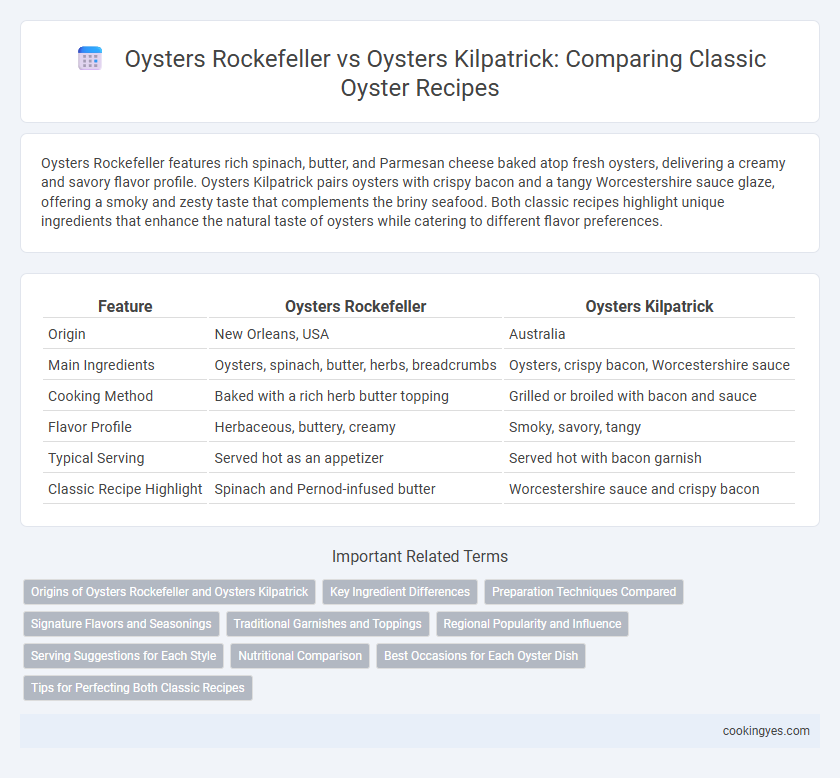Oysters Rockefeller features rich spinach, butter, and Parmesan cheese baked atop fresh oysters, delivering a creamy and savory flavor profile. Oysters Kilpatrick pairs oysters with crispy bacon and a tangy Worcestershire sauce glaze, offering a smoky and zesty taste that complements the briny seafood. Both classic recipes highlight unique ingredients that enhance the natural taste of oysters while catering to different flavor preferences.
Table of Comparison
| Feature | Oysters Rockefeller | Oysters Kilpatrick |
|---|---|---|
| Origin | New Orleans, USA | Australia |
| Main Ingredients | Oysters, spinach, butter, herbs, breadcrumbs | Oysters, crispy bacon, Worcestershire sauce |
| Cooking Method | Baked with a rich herb butter topping | Grilled or broiled with bacon and sauce |
| Flavor Profile | Herbaceous, buttery, creamy | Smoky, savory, tangy |
| Typical Serving | Served hot as an appetizer | Served hot with bacon garnish |
| Classic Recipe Highlight | Spinach and Pernod-infused butter | Worcestershire sauce and crispy bacon |
Origins of Oysters Rockefeller and Oysters Kilpatrick
Oysters Rockefeller originated in New Orleans in 1899, created by chef Jules Alciatore at Antoine's Restaurant, featuring a rich green sauce made from ingredients like spinach and herbs. Oysters Kilpatrick was developed in Australia, typically consisting of oysters topped with Worcestershire sauce and bacon, offering a smoky and savory flavor. Both dishes represent classic oyster preparations with distinct regional origins and unique flavor profiles.
Key Ingredient Differences
Oysters Rockefeller features a rich topping of spinach, herbs, and parmesan cheese, creating a creamy, savory flavor profile. In contrast, Oysters Kilpatrick is distinguished by its smoky, tangy blend of Worcestershire sauce and crispy bacon bits. These key ingredient differences define the distinct tastes of these classic oyster recipes.
Preparation Techniques Compared
Oysters Rockefeller involves topping oysters with a rich mixture of spinach, parsley, and other herbs, then baking them with a butter-based sauce to create a creamy texture and vibrant flavor. Oysters Kilpatrick features oysters topped with crispy bacon and a spiced Worcestershire sauce glaze, broiled for a smoky, savory finish. Both classic recipes emphasize different preparation techniques: Rockefeller uses baking with a herbaceous sauce, while Kilpatrick relies on broiling with bacon and bold seasoning.
Signature Flavors and Seasonings
Oysters Rockefeller features a signature blend of rich spinach, parsley, butter, and Parmesan cheese, delivering a creamy texture and herbaceous flavor enhanced by a hint of anise from Pernod or similar liqueur. Oysters Kilpatrick offers a distinct savory experience with crispy bacon, Worcestershire sauce, and a touch of lemon, creating a smoky, tangy profile that complements the briny oysters. Both classic recipes highlight oysters' natural umami while showcasing unique seasoning combinations that cater to different flavor preferences.
Traditional Garnishes and Toppings
Oysters Rockefeller features a rich topping of spinach, herbs, and breadcrumbs, often enhanced with Pernod or anise-flavored liqueur, creating a vibrant green herbaceous flavor profile. Oysters Kilpatrick is traditionally garnished with crispy bacon and a tangy Worcestershire sauce, delivering a smoky and savory taste contrast. Both classic recipes highlight unique toppings that define their distinct culinary identities in oyster dishes.
Regional Popularity and Influence
Oysters Rockefeller, originating in New Orleans, showcases a rich blend of spinach, herbs, and butter, embodying Southern culinary tradition and enjoying widespread popularity along the Gulf Coast. Oysters Kilpatrick, featuring Worcestershire sauce and crispy bacon, holds a distinct place in Australian cuisine, particularly in Sydney and Melbourne, reflecting local tastes and seafood culture. These classic recipes highlight regional influence through their unique ingredient profiles and enduring presence in their respective culinary scenes.
Serving Suggestions for Each Style
Oysters Rockefeller are traditionally served on the half shell with a rich topping of spinach, herbs, and breadcrumbs, baked until golden, perfect for elegant appetizer presentations on a bed of rock salt or chopped parsley. Oysters Kilpatrick feature cooked oysters topped with crispy bacon and Worcestershire sauce, often served hot on a platter with lemon wedges, ideal for adding a smoky, tangy flavor that complements casual dining setups. Both recipes are best paired with chilled dry white wine or Champagne to balance the savory richness and enhance the seafood experience.
Nutritional Comparison
Oysters Rockefeller typically contain spinach, butter, and cheese, contributing to higher fat and calorie content compared to Oysters Kilpatrick, which are topped with bacon and Worcestershire sauce, adding more protein and sodium. Nutritionally, Oysters Rockefeller offers more iron and calcium due to the greens and cheese, while Oysters Kilpatrick provides increased protein from bacon but also elevated saturated fats. Both recipes deliver essential omega-3 fatty acids present in oysters but differ significantly in their macronutrient profiles based on their rich toppings.
Best Occasions for Each Oyster Dish
Oysters Rockefeller, with their rich blend of spinach, butter, and Parmesan, are ideal for upscale events like cocktail parties and holiday dinners, offering a luxurious appetizer that impresses guests. Oysters Kilpatrick, topped with crispy bacon and Worcestershire sauce, suit casual gatherings such as backyard barbecues or game days, providing a smoky, flavorful bite that complements relaxed atmospheres. Both classic oyster dishes enhance occasions by matching their distinctive flavors and presentation styles to the event's tone and guest preferences.
Tips for Perfecting Both Classic Recipes
Achieving the perfect Oysters Rockefeller requires fresh oysters topped with a rich blend of spinach, parsley, and Pernod, baked until the topping is golden and bubbly. For Oysters Kilpatrick, balance smoky Worcestershire sauce and crispy bacon bits to enhance the oysters' natural briny flavor, broiling just until the bacon crisps without overcooking the oysters. Use fresh, firm oysters and precise timing to maintain texture and flavor integrity in both classic recipes.
Oysters Rockefeller vs Oysters Kilpatrick for classic recipes Infographic

 cookingyes.com
cookingyes.com